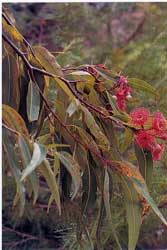Eucalyptus or Gum Trees
 Eucalyptus are commonly called Gum Trees. There are around 800 species plus varieties and some hybrids. (Some authorities have split Eucalypts into 2 genera – Eucalyptus & Corymbia).
Eucalyptus are commonly called Gum Trees. There are around 800 species plus varieties and some hybrids. (Some authorities have split Eucalypts into 2 genera – Eucalyptus & Corymbia).
There are trees suited to most requirements (eg. as a shade tree, a flowering feature, for attractive foliage or bark effects). Leaves do drop all year round, and can be a nuisance in a pool, or over large paved areas. Gum tree leaves are useful also though; containing oils that deter weed growth; making them useful in a bush garden, or above predominantly mulched gardens.
Some are small almost shrub like, while others are very tall trees. Most have tough, leathery, simple leaves, which are often aromatic, some are very attractive. Flowers vary considerably in size, colour and season - reds, pinks, yellows and whites are common. Some are very attractive.
Requirements are extremely variable. There is a Eucalypt for just about any position, from harsh, arid conditions to rainforests, to sub-alpine regions to boggy areas. Most are generally very hardy, in the right position. Most develop strong tap roots, and are very difficult to transplant once established. They are subject to a wide range of pests and diseases, but if growing vigorously will generally cope quite well. Growth rates are usually fast to very fast. If pollarded (top cut out to reduce height) then this must be redone every two or three years to reduce the likelihood of large branches dropping. Established trees respond well to feeding and watering in dry seasons. The majority are readily propagated from seed. The seed of some alpine species may require stratification for 2-3 months prior to sowing. Selected forms are sometimes propagated by grafting or tissue culture.
Cultivars
The following are some of the more decorative types.
E. alpina (Grampians Gum) - Normally upright to 5m tall, with large thick leathery leaves. This is a hardy plant that grows well in high or medium rainfall areas, in a temperate climate. It is frost resistant, and will resist some snow. Cream coloured flowers. Some clones can be much smaller; and others much taller though, so you need to be sure of the parentage to be sure of the eventual plant height.
E. caesia (Gungurru) - A spectacular plant whether in flower or not, clusters of large pinkish- red flowers burst from powdery whitish buds. Bark is often also powdery white, but can also show reddish colouration, depending on the cultivar and time of year. To 5m tall, with long weeping branches, and green or greyish green foliage. Frost tender when young, best in sandy or loam soils. It can be difficult in wet or hard soils, or in extremely cold or humid climates.
E. cornuta (Yate) - 4 to 6m tall, frost and drought tolerant, attractive yellow green flowers.
E. crenulata (Silver Gum) - 5 to 10m tall, grows on wet soils (naturally occurs in swamps); prized for silvery grey foliage, white flowers, greyish bark made attractive by silvery markings, hardy on a wide variety of soils.
E. erythrocorys (Red Cap Gum) - To 6m tall, slender upright habit, large attractive red buds followed by yellowish flowers; does well in sandy or clay soils, likes an alkaline soil protected from strong winds.
E. forrestiana (Fuchsia Gum) - 4 to 5m tall, seedlings are frost sensitive; but hardy once fully grown; Very attractive large clusters of open to colourful masses of pinkish-red flowered flower buds, green foliage with reddish tinges.
E. macrocarpa (Mottlecah) - The largest of all Eucalypt flowers, with red flowers to 15cm diameter, set against silver grey foliage which creates a very unique and spectacular effect. This plant would be grown much more if it were easier. It does not do well in heavy soils, or if exposed to any significant frosts (particularly when young). It gets to 3 or 4m tall, but can have a sprawling shape, more like an open shrub than a tree, unless trained with regular pruning. It suits low humidity climates.
E. preissiana (Bell Fruited Mallee) Usually to 4 m tall, with large attractive yellow flowers; needs pruning to maintain a tree shape and avoid untidy sprawling shape, does well in poorer or clay soils; medium frost resistant, suits low humidity climates best.
Learn More about Plants through an ACS Plant Variety course.
Click for details: http://www.hortcourses.com/courses/product_listings.aspx?catid=Plant+Varieties
For Australian Native Plants, Click here http://www.hortcourses.com/courses/product_listings.aspx?catid=Australian+Native+Plants
You may also be interested in....